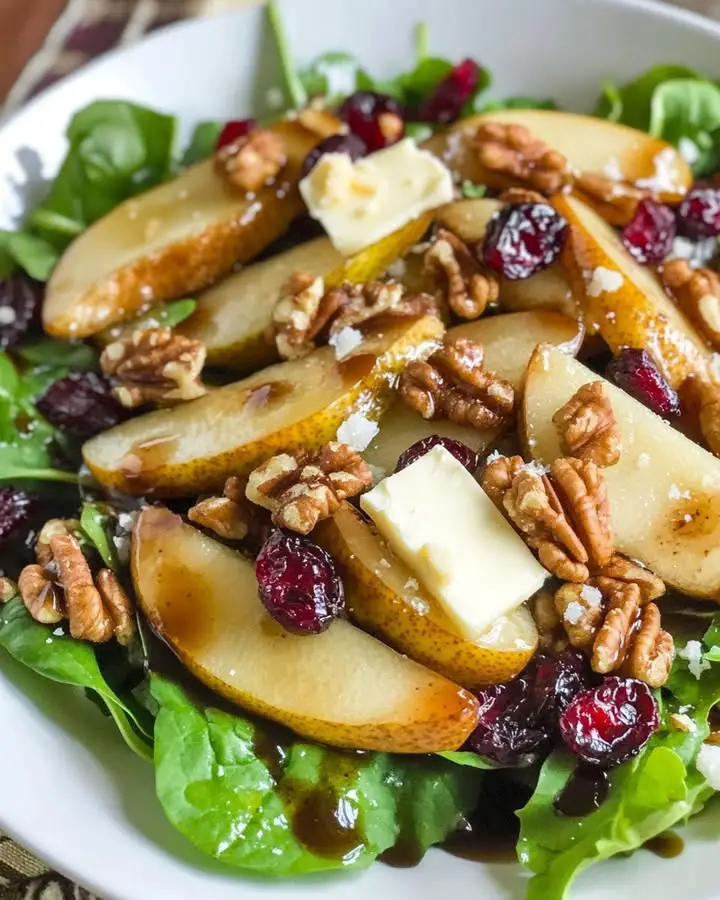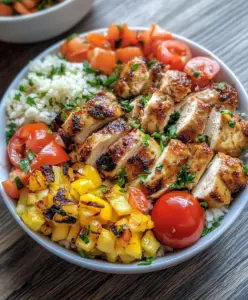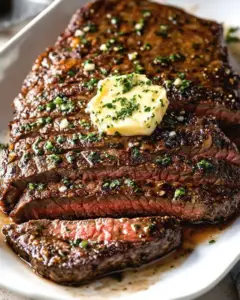Best Fall Harvest Pear Salad Recipe: A Seasonal Delight
This Best Fall Harvest Pear Salad Recipe brings together the crisp sweetness of autumn pears with hearty greens and a tangy dressing. As the leaves change color, this salad captures the essence of fall in every bite. Whether you serve it as a starter or a light meal, it delivers fresh flavors and vibrant textures.
Imagine juicy pears mingling with crunchy nuts and creamy cheese atop a bed of leafy greens. The combination creates a perfect balance of sweet, savory, and tangy notes. Moreover, this dish works beautifully for weeknight dinners or holiday gatherings. With minimal prep time, you can whip up a salad that impresses everyone at the table.
Quick Recipe Highlights
- Flavor Profile: The salad features sweet pears, tangy dressing, and savory cheese for a well-rounded taste.
- Texture: Crisp greens, juicy pears, and crunchy nuts create a delightful contrast.
- Aroma: Fresh herbs and toasted nuts enhance the salad’s inviting fragrance.
- Visual Appeal: Vibrant greens, golden pears, and toasted nuts make the dish look stunning.
- Skill Level Needed: Beginners can easily prepare this recipe with simple steps.
- Special Equipment: A sharp knife and mixing bowl are all you need.
Recipe Overview
- Difficulty Level: This recipe requires basic chopping and mixing skills, making it accessible to all.
- Category: Perfect as a starter, side dish, or light lunch.
- Cuisine: Inspired by seasonal American and European flavors.
- Cost: Affordable ingredients make this salad budget-friendly.
- Season: Best enjoyed during fall when pears are at their peak.
- Occasion: Ideal for family dinners, potlucks, or holiday meals.
Why You’ll Love This Recipe
The Best Fall Harvest Pear Salad Recipe offers a burst of seasonal flavors in every bite. First, the sweetness of ripe pears pairs perfectly with tangy dressing. Additionally, the crunchy nuts add a satisfying texture that elevates the dish. You’ll appreciate how quickly it comes together, making it perfect for busy days.
Beyond taste, this salad provides nutritional benefits. Pears deliver fiber, while leafy greens offer essential vitamins. Furthermore, the nuts contribute healthy fats and protein. Whether you follow a specific diet or simply enjoy fresh food, this salad fits seamlessly into your routine.
Entertaining becomes effortless with this recipe. Guests will admire the beautiful presentation and bold flavors. Plus, you can customize it with different cheeses or nuts to suit preferences. The versatility ensures everyone finds something to love.
Cost-wise, this salad uses simple, seasonal ingredients that won’t break the bank. Pears, greens, and nuts are readily available during fall. Consequently, you can enjoy gourmet flavors without overspending. The recipe also scales easily for larger gatherings.
Finally, the dish adapts well to various dietary needs. Gluten-free and vegetarian guests can enjoy it without modifications. With so many benefits, this salad deserves a spot in your fall meal rotation.
Historical Background and Cultural Significance
Pear salads have roots in European cuisine, where seasonal fruits often enhance savory dishes. Historically, cooks paired pears with cheese and nuts for balanced flavors. Over time, the combination gained popularity in American cooking, especially during harvest seasons.
Different regions developed unique variations of pear salads. For example, French versions often include blue cheese, while Italian renditions might feature prosciutto. These adaptations highlight how versatile pears are in culinary traditions.
Modern interpretations focus on fresh, local ingredients. Chefs now emphasize organic greens and artisanal cheeses. This evolution reflects broader food trends toward sustainability and quality. The Best Fall Harvest Pear Salad Recipe builds on these traditions while keeping preparation simple.
Today, pear salads symbolize autumn’s bounty. They appear on menus during harvest festivals and Thanksgiving dinners. Their enduring appeal lies in the perfect balance of sweet and savory elements. This timeless combination continues to delight diners worldwide.
Ingredient Deep Dive
Pears take center stage in this recipe. Choose ripe but firm varieties like Bartlett or Anjou for the best texture. These pears offer natural sweetness without becoming mushy. Store them at room temperature until ripe, then refrigerate to extend freshness.
Leafy greens form the salad’s base. Opt for a mix of arugula and spinach for peppery and mild flavors. These greens provide vitamins A and C while adding vibrant color. Always wash and dry greens thoroughly to ensure crispness.
Cheese adds richness to the dish. Crumbled goat cheese or blue cheese work beautifully. Both options deliver tangy notes that complement the pears. If you prefer milder flavors, try feta or shaved Parmesan instead.
Nuts contribute crunch and depth. Toasted walnuts or pecans enhance the salad’s texture. Toasting intensifies their flavor, so don’t skip this step. For nut-free versions, sunflower seeds make an excellent substitute.
Common Mistakes to Avoid
- Using overripe pears: They turn mushy and lack texture.
- Skipping the toasting step for nuts: Raw nuts lack depth of flavor.
- Drowning the salad in dressing: Start with a small amount and add more as needed.
- Not washing greens properly: Grit ruins the eating experience.
- Adding dressing too early: The greens wilt if dressed prematurely.
- Using pre-shredded cheese: Freshly crumbled cheese tastes better.
- Overcomplicating the ingredient list: Simplicity highlights the best flavors.
- Ignoring seasoning: A pinch of salt enhances all the components.
Pro Tips for Perfect Pear Salad
Slice pears just before serving to prevent browning. If prepping ahead, toss them with lemon juice. This trick maintains their fresh appearance.
Toast nuts in a dry skillet for even browning. Watch them closely, as they burn quickly. Let them cool before adding to the salad.
Make the dressing in advance to save time. Shake it in a jar for easy emulsification. Adjust the sweetness or acidity to your taste.
Layer ingredients thoughtfully for visual appeal. Place greens first, then arrange pears and cheese artfully. Finish with a sprinkle of nuts.
Serve the salad chilled for maximum freshness. Keep ingredients refrigerated until assembly. Cold temperatures enhance the crisp textures.
Experiment with different pear varieties for unique flavors. Each type brings subtle differences in sweetness and texture.
Variations and Adaptations
For a heartier meal, add grilled chicken or shrimp. These proteins turn the salad into a complete entrée. Alternatively, crispy bacon bits offer a smoky twist.
Vegan versions can omit cheese or use plant-based alternatives. Nutritional yeast adds a cheesy flavor without dairy. Maple syrup works well in place of honey in the dressing.
Winter adaptations might include roasted squash or pomegranate seeds. These additions bring seasonal flavors and vibrant colors. Similarly, summer versions could feature fresh berries instead of pears.
Gluten-free guests can enjoy this salad as-is. Just ensure any added toppings, like croutons, are gluten-free. Many stores carry suitable options.
For extra crunch, try adding roasted chickpeas. They provide protein and fiber while keeping the dish vegetarian. Spiced varieties add an exciting kick.
Serving and Presentation Guide
Use a large platter for family-style serving. Arrange ingredients in sections for a rustic look. Alternatively, individual plates create an elegant presentation.
Garnish with edible flowers or herb sprigs for special occasions. These touches elevate the dish visually. Microgreens also add a gourmet flourish.
Serve dressing on the side for gatherings. This approach lets guests control their portions. Provide a small pitcher or bowl for convenience.
Consider pairing with crusty bread or soup for a complete meal. The salad complements many fall dishes beautifully. These combinations make satisfying menus.
Chill plates before serving for professional results. Cold surfaces keep the salad crisp longer. This technique works especially well in warm weather.
Wine and Beverage Pairing
White wines like Riesling or Chardonnay complement the salad’s flavors. Their acidity balances the sweetness of pears. For red lovers, Pinot Noir offers a light, fruity option.
Non-alcoholic choices include sparkling water with citrus. The bubbles cleanse the palate between bites. Herbal teas like chamomile also pair nicely.
Apple cider makes a festive fall alternative. Its natural sweetness mirrors the pears’ flavor. Serve it warm or chilled depending on preference.
Coffee lovers might enjoy a light roast with the salad. The beverage’s bitterness contrasts the dish’s sweetness. Avoid heavy, dark roasts that could overwhelm.
Storage and Shelf Life
Store undressed salad in an airtight container for up to a day. Keep nuts separate to maintain crunch. Add dressing just before serving.
Leftovers lose crispness but still taste good. Consume them within 24 hours for best quality. The pears may soften slightly over time.
Freezing isn’t recommended for this salad. The greens and pears don’t thaw well. Instead, prepare only what you’ll eat fresh.
If making components ahead, store them separately. Dressings keep for a week refrigerated. Toasted nuts stay fresh in airtight containers for days.
Make Ahead Strategies
Prep ingredients the night before to save time. Wash and dry greens, then wrap them in towels. Store pears whole until slicing time.
Toast nuts up to three days in advance. Cool completely before storing. They retain flavor and crunch when sealed properly.
Whisk dressing ingredients together ahead. Refrigerate in a jar with a tight lid. Shake well before using to recombine.
Assemble the salad just before serving. This timing ensures optimal texture. If necessary, layer ingredients in the bowl without tossing.
For packed lunches, pack components separately. Combine at mealtime for freshness. Small containers keep everything organized.
Scaling Instructions
Double the recipe easily for larger groups. Use a bigger bowl to accommodate more ingredients. Increase dressing proportionally.
For smaller servings, halve all quantities. A single pear typically serves two people. Adjust other ingredients accordingly.
When scaling up, toast nuts in batches. This method ensures even browning. Overcrowding the pan leads to uneven results.
Consider individual plating for large events. Pre-portion ingredients for efficient service. This approach prevents last-minute scrambling.
Remember that dressing needs may vary. Start with less when increasing quantities. You can always add more as needed.
Nutritional Deep Dive
This salad provides balanced nutrition in every serving. Pears contribute fiber and vitamin C. Greens offer iron and antioxidants.
Nuts add healthy fats and protein. These nutrients promote satiety and heart health. Moderate portions keep calories in check.
Cheese provides calcium and probiotics. Choose lower-fat versions if watching calories. The dressing’s olive oil offers monounsaturated fats.
Overall, the dish fits well into various eating plans. Its plant-based ingredients support wellness goals. The combination of nutrients sustains energy levels.
For specific dietary tracking, weigh ingredients precisely. Online calculators help determine exact values. This method ensures accurate portion control.
Dietary Adaptations
Gluten-free diners can enjoy this salad as written. Verify that any added ingredients meet standards. Many cheeses and nuts are naturally gluten-free.
Dairy-free versions omit cheese or use alternatives. Nutritional yeast or vegan cheeses work well. Check dressing ingredients for hidden dairy.
Vegan adaptations replace honey with maple syrup. Plant-based cheeses mimic the original texture. These swaps maintain the dish’s essence.
Low-carb options reduce pear quantity slightly. Increase greens and nuts for bulk. The dressing already suits most low-carb plans.
Nut allergies require seed substitutions. Sunflower or pumpkin seeds provide similar crunch. Always check for cross-contamination risks.
Troubleshooting Guide
If greens wilt, they may have too much moisture. Dry them thoroughly after washing. A salad spinner works best for this.
Soggy pears indicate overripeness. Choose firmer fruit next time. Lemon juice also helps prevent excess softening.
Bitter dressing needs balancing. Add a touch more sweetener or oil. Taste as you go to achieve harmony.
Burnt nuts result from inattention. Use medium-low heat and stir frequently. They continue cooking after removal from heat.
Uneven flavors suggest improper mixing. Toss the salad gently but thoroughly. Ensure dressing coats all components.
Frequently Asked Questions
Can I use canned pears? Fresh pears work best for texture and flavor. Canned varieties become too soft and lack freshness.
What’s the best pear variety for salads? Bartlett and Anjou hold up well. Bosc pears also work with their firm texture.
Can I make this salad ahead? Prep ingredients separately, then combine before serving. This method maintains optimal texture.
What cheese substitutes work well? For vegan options, try almond feta or cashew cheese. Both provide similar creaminess.
How do I prevent pear browning? Toss slices with lemon juice or vinegar. This acid slows oxidation effectively.
Can I use bottled dressing? Homemade tastes fresher, but bottled works in a pinch. Choose light vinaigrettes for best results.
What greens work besides arugula? Spinach, kale, or mixed baby greens all pair well. Avoid iceberg for better nutrition.
How long do leftovers last? Consume within a day for best quality. The texture softens over time.
Can I add protein to this salad? Grilled chicken, shrimp, or tofu all complement the flavors beautifully.
What nuts work besides walnuts? Pecans, almonds, or hazelnuts all add delicious crunch. Toast them for maximum flavor.
Additional Resources
Explore more fall salad recipes featuring seasonal produce. Combinations with apples, squash, or cranberries offer variety. These dishes capture autumn’s essence.
Learn proper knife skills for efficient pear preparation. Sharp knives and correct techniques ensure even slices. Many online tutorials demonstrate these methods.
Discover homemade dressing variations to customize flavors. Experiment with different vinegars and oils. These small changes create entirely new profiles.
Investigate local farmers’ markets for fresh ingredients. Seasonal pears and greens often taste superior. Supporting local growers benefits communities.
Consider pairing this salad with seasonal soups. Butternut squash or mushroom varieties make excellent companions. These combinations create satisfying meals.
PrintBest Fall Harvest Pear Salad Recipe
Description
A refreshing and vibrant salad featuring seasonal pears, mixed greens, and a tangy vinaigrette.
Ingredients
For the Crust:
- 4 cups mixed greens (arugula, spinach, kale)
- 2 ripe pears, thinly sliced
- 1/2 cup crumbled goat cheese
- 1/4 cup dried cranberries
- 1/4 cup chopped walnuts
- 2 tbsp olive oil
- 1 tbsp balsamic vinegar
- 1 tsp honey
- Salt and pepper to taste
Instructions
1. Prepare the Crust:
- In a large bowl, combine the mixed greens, sliced pears, goat cheese, dried cranberries, and walnuts.
- In a small bowl, whisk together the olive oil, balsamic vinegar, honey, salt, and pepper to make the dressing.
- Drizzle the dressing over the salad and toss gently to combine. Serve immediately.
Notes
You can customize the seasonings to taste.




